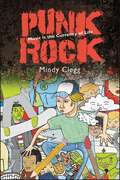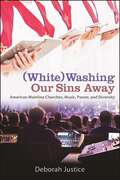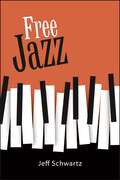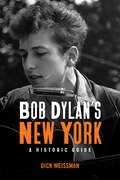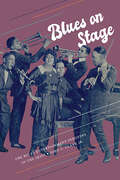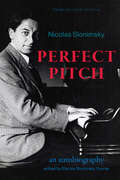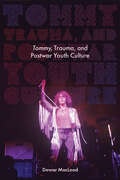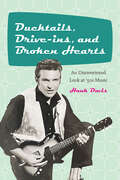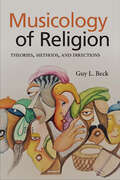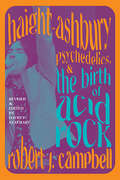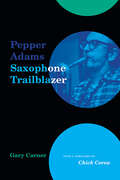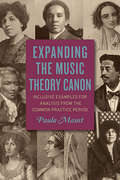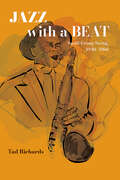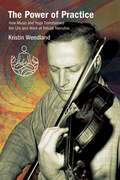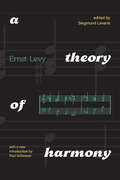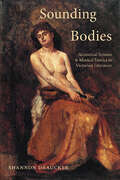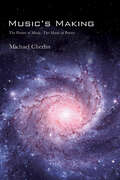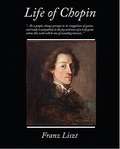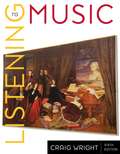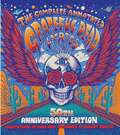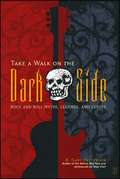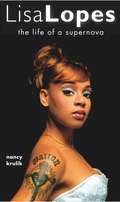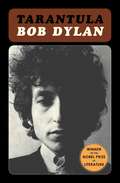- Table View
- List View
Punk Rock: Music Is the Currency of Life
by Mindy CleggPunk Rock examines the history of punk rock in its totality. Punk became a way of thinking about the role of culture and community in modern life. Punks forged real alternatives to producing popular music and built community around their music. This punk counterpublic, forged in the late Cold War period, spanned the globe and has provided a viable cultural alternative to alienated young people over the years. This book starts with the rise of modernity and places the emergence of punk as a musical subculture into that longer historical narrative. It also reveals how punk itself became a contested terrain, as participants sought to imbue the production of music with greater meaning. It highlights all styles of punk and its wide variety of creators around the world, including from the LGBTQ+, feminist, and alternative communities. Punk was and remains a transnational phenomenon that influences music production and shapes our understanding of culture’s role in community building.
(White)Washing Our Sins Away: American Mainline Churches, Music, Power, and Diversity
by Deborah JusticeWhat if simply changing musical styles could resurrect social power and religious vitality? By the early 1990s, Christianity was losing ground nationally, and mainline Protestants were trending even Whiter and older than America's overall demographic trajectory. The churches knew they needed to diversify. Yet, many mainline churches focused their energies on the so-called Worship Wars, intense aesthetic and theological controversies running through much of White Christian America. Historically, churches had only supported one musical style; now, many mainline Protestant congregations were willing to risk internal schism to support both Contemporary worship—centered around guitars, praise bands, and choruses—and Traditional worship with its pipe organs, chancel choirs, and hymns. Surely, they thought, musical diversity would broadcast tolerance and bring in new members—perhaps it would even help them regain their historically central role in American society. Based on years of ethnographic research, (White)Washing Our Sins Away explores how American mainline Protestants used internal musical controversies to negotiate their shifting position within the nation's diversifying religious and sociopolitical ecosystems.
Free Jazz: A Research And Information Guide (SUNY Press Jazz Styles)
by Jeff SchwartzIn the late 1950s, free jazz broke all the rules, liberating musicians both to create completely spontaneous and unplanned performances and to develop unique personal musical systems. This genre emerged alongside the radical changes of the 1960s, particularly the Civil Rights, Black Arts, and Black Power movements. Free Jazz is a new and accessible introduction to this exciting, controversial, and often misunderstood music, drawing on extensive research, close listening, and the author’s experience as a performer. More than a catalog of artists and albums, the book explores the conceptual areas they opened: freedom, spirituality, energy, experimentalism, and self-determination. These are discussed in relation to both the political and artistic currents of the times and to specific musical techniques, explained in language clear to ordinary readers but also useful for musicians.
Bob Dylan's New York: A Historic Guide (Excelsior Editions)
by Dick WeissmanBob Dylan’s New York is a guidebook and a history of New York's key role through Dylan's lengthy career. It places Dylan’s early career in the storied history of Greenwich Village, a hotbed of new developments in the arts. A contemporary of Dylan’s, author Dick Weissman walked the same streets, played music in the same venues, and witnessed the growth of the folk music revival from before Dylan became popular to after the height of his impact on the music scene. The book features ten easy-to-follow walking maps and historic photographs, allowing the reader to retrace Dylan’s footsteps and simultaneously experience Dylan’s New York and contemporary New York. It also goes beyond the Village to include the many areas of the city where Dylan lived and worked, as well as the storied time he spent in Woodstock. Combining cultural history with personal history and anecdotes, Bob Dylan’s New York illuminates the life and times of this seminal artist.
Blues on Stage: The Blues Entertainment Industry in the 1920s (SUNY Press Jazz Styles)
by John L. ClarkBlues on Stage presents a new history of the development of the "Classic Blues" of the 1920s, offering a comprehensive review of various Black singers who recorded and were influential in this era, including Bessie Smith, Trixie Smith, Butterbeans and Susie, and Ma Rainey. The business of music recording and publishing, including songwriting and touring theater circuits, is explored as part of the narrative of how and when these artists became nationally popular. The most highly regarded singers of this period were not folk or rural artists, but rather highly experienced stage professionals whose careers often extended two decades or more prior to their first recordings. These artists, some of the most famous acts on the Black vaudeville and tent show circuits, were preceded in the recording studio by many cabaret and nightclub singers with a different entertainment perspective and were followed by artists who came from a more rural, less professional background. For anyone interested in the roots of jazz and blues, Blues on Stage offers a new and comprehensive introduction to the development of this American musical style.
Perfect Pitch, Third Revised Edition: An Autobiography (Excelsior Editions)
by Nicolas SlonimskyPerfect Pitch tells the compelling story of Nicolas Slonimsky. A boy prodigy as a pianist, Slonimsky fled pre-Communist Russia, reaching Paris at the height of another revolution—one in music and the arts. His early association with conductor Serge Koussevitzky brought him into contact with many of the era's greatest talents, including Igor Stravinsky and Serge Prokofiev. Emigrating to Boston in 1925, he embarked on a writing career, authoring key works still in print decades after their first publication, including Music Since 1900, a chronological history; Lexicon of Musical Invective, which proved definitively that new works are rarely understood in their time; and Thesaurus of Scales and Melodic Patterns, which inspired generations of composers and performers, including jazz saxophonist John Coltrane. Known for his sharp wit, Slonimsky appeared on The Tonight Show with Johnny Carson and was befriended by Frank Zappa. Perfect Pitch captures a life that was rich with discovery and invention and spanned a century of revolutions and explorations. This new edition is enhanced with several previously unpublished photographs, an extensive oral history, and several original essays, some reprinted for the first time.
Tommy, Trauma, and Postwar Youth Culture (Excelsior Editions)
by Dewar MacLeodTommy, Trauma, and Postwar Youth Culture traces the development of one of rock music's central masterpieces and its relation to the social-cultural history of the era. Composer and guitarist Pete Townshend was the creative force behind the Who, one of Britain's greatest rock bands. Townshend grew up in an England decimated by the loss of life and hope that was the initial legacy of World War II. The product of a troubled childhood, Townshend faced ongoing struggles with sexual and personal trauma that colored his later work as a performer. An ambitious composer who wanted to create both pop hits and lasting personal works, Townshend achieved his greatest success with the Who through their 1969 rock opera, Tommy. Townshend gave many accounts of the work's evolution and its significance to him and he participated in and encouraged its continued legacy. Dewar MacLeod recounts his own interactions with Townshend and Tommy to draw out the work's impact, its critical reception, its place both in postwar history and the rock era, and its continuing relevance. This book will appeal to all interested in the history of rock, the creative process, and the long shadow of the 1960s.
Ducktails, Drive-ins, and Broken Hearts: An Unsweetened Look at '50s Music (Excelsior Editions)
by Hank DavisThey all tried, but few singers and musicians from the 1950s became stars. Yet many of them had stories to tell that were far more interesting than the ones you already know. Author Hank Davis was bitten by the music bug as a teenager. By the time he entered college in 1959, he was no stranger to New York's recording studios and had a few 45s of his own on the market.Spanning a 45 year career in music journalism, Davis has spent time backstage, in motel rooms, and on tour buses to uncover stories that rarely made the official annals of pop music history. Based on hundreds of hours of interviews and new research, Ducktails, Drive-Ins, and Broken Hearts offers a fascinating, behind-the-scenes look at the winners and losers during rock 'n' roll's formative era.How did a decade as uptight and puritanical as the '50s produce so much cringe-worthy, politically incorrect music? What was it like to see a pale cover version of your latest record climb the charts while yours sat unplayed by mainstream radio stations? How did precious Elvis tapes end up in a Memphis landfill? And who was that thirteen-year-old girl who made a five-dollar vanity record at Sun just two years after Elvis had—and ended up singing backup on "Suspicious Minds" and "In the Ghetto?" This book is a must-read for all fans of '50s music.In the words of Jerry Phillips, son of Sun Records founder, Sam Phillips, "Hank Davis is one of the few guys who really gets it."
Musicology of Religion: Theories, Methods, and Directions (SUNY series in Religious Studies)
by Guy L. BeckFor generations, religion and music have been regarded as "universals," yet despite the fact that they have been frequently linked throughout history and topography, and despite the importance of music in the early stages of religious studies, their combined presence has not until now been considered a separate area of study and research. While there are well-developed fields of anthropology of religion, psychology of religion, and philosophy of religion, the widely recognized connections between religion and sound, chant, and music warrant comparable study. Drawing upon theories and methods in the study of both religion and music, referencing examples from world religious traditions, and addressing challenges posed by critics, this book envisions a unified field for religion and music: musicology of religion. Grounded in the scope and methods of phenomenology and comparative analysis, musicology of religion represents an innovative direction in interdisciplinary study, enriched by the social sciences, ethnomusicology, philosophy, theology, liturgical studies, and cognitive studies. As conceived, musicology of religion will spearhead new and creative paths in the study of religion.
Haight-Ashbury, Psychedelics, and the Birth of Acid Rock (Excelsior Editions)
by Robert J. CampbellCombining literature, social history, and personal experience, author Robert J. Campbell traces the birth, downfall, and legacy of the innovative, playful, and spontaneous counterculture launched in 1960s Haight-Ashbury. In a lively writing style, Campbell describes the discovery of LSD, its slow adoption, and the promotion of it by Timothy Leary and Ken Kesey, who each became missionaries for the drug. Campbell relates how LSD allowed users to enhance the perception of alternative realities and describes its wide-scale use in the Haight-Ashbury District of San Francisco from 1964 to 1967 that led to imaginative and creative change, including collaborative behavior, a new way of looking at the world, acid rock, and a host of other paradigm shifts. Haight-Ashbury, Psychedelics, and the Birth of Acid Rock concludes by examining the inherent dangers of constant drug use as well as the positive legacy of the 1960s, including a focus on health food, cooperative living arrangements, recycling, battling climate change, free medical help, and personal responsibility. The book incorporates ideas from a broad range of disciplines for general readers for a unique and fresh look at this impactful era.
Pepper Adams: Saxophone Trailblazer (Excelsior Editions)
by Gary CarnerPepper Adams is more than a definitive biography of Park "Pepper" Adams (1930–1986). The culmination of thirty-seven years of research, it's a fascinating account of Adams's life and times, thanks to colorful vignettes drawn from the author's 250 unpublished conversations with Adams and other esteemed musicians. These candid observations about Adams and his colleagues reveal previously confidential aspects of Adams's complex personality, his many outstanding achievements, and little-known facts about musicians with whom he worked, such as Thad Jones, Miles Davis, Charlie Parker, John Coltrane, Elvin Jones, Charles Mingus, Stan Kenton, Duke Ellington, Bobby Timmons, Wardell Gray, Dizzy Gillespie, Thelonious Monk, and others. Musicians, jazz fans and collectors, and readers who enjoy a hero's journey will be intrigued by Adams's extraordinary intelligence, the extent of his influence, the reverence he commanded, and his struggle to be rewarded as the unique stylist that he was throughout his career. Moreover, readers will be enlivened by the author's unique approach to biography, in which storytelling moves thematically, sometimes in reverse chronological order.
Expanding the Music Theory Canon: Inclusive Examples for Analysis from the Common Practice Period
by Paula MaustFeaturing music by sixty-seven historical women and/or people of color, Expanding the Music Theory Canon is designed to supplement any introductory Western classical music theory curriculum. At a time when many academics are focused on increasing diversity and inclusion, this book provides the means to seamlessly incorporate works by underrepresented composers into music theory core courses. The anthology’s 255 musical examples are organized topically and include excerpts as well as nineteen complete pieces for analysis. Each chapter begins with guided analysis questions aimed at students approaching these concepts for the first time. Notably, this anthology provides a biography and image for each composer, which is particularly significant since works by these individuals have rarely been included in previous textbooks or anthologies. A related website, www.expandingthemusictheorycanon.com, provides additional examples and links to recordings when available. All musical examples in the anthology have been classroom-tested with music majors and minors at a major conservatory, at private and public universities, and at community colleges. Detailed tables provide suggestions for using this book in conjunction with the major introductory theory textbooks. A special set of online exercises has been prepared by the book's author using the Auralia & Musition software programs; you can find further information here: https://www.risingsoftware.com/expanding-the-music-theory-canon. Additional examples and a blog offering teaching suggestions may be found at: https://www.expandingthemusictheorycanon.com.
Jazz with a Beat: Small Group Swing, 1940–1960 (Excelsior Editions)
by Tad RichardsJazz with a Beat is the first book on the often overlooked but vitally important genre of small group swing jazz. Coming into being in the early 1940s, small group swing answered the need in the Black community for a form of jazz that was more accessible (and more danceable) than the new bebop. An adaptation of the big band Black swing (Erskine Hawkins, Jimmie Lunceford, Chick Webb) of the 1930s to small combos, and with a more vigorous beat for the new generation, this music developed and was beloved through the 1940s, continued to be enjoyed through the rock and roll years of the 1950s, and was a major influence on the soul jazz of the 1960s. Among the many hit artists portrayed in these pages are Illinois Jacquet, Louis Jordan, Big Jay McNeely, Joe Liggins, Nat "King" Cole, Red Prysock, Ruth Brown, Nellie Lutcher, Camille Howard, T-Bone Walker, and Ray Charles. Dismissed as "rhythm and blues," this music has been ignored by jazz historians. Jazz with a Beat honors this music as a legitimate genre of jazz and is a stirring evocation of an era. It should be of interest to lovers of jazz and Americana.
The Power of Practice: How Music and Yoga Transformed the Life and Work of Yehudi Menuhin (SUNY Press Open Access)
by Kristin WendlandThe Power of Practice showcases the pioneering achievements of renowned violinist Yehudi Menuhin (1916-99) and how both disciplines transformed his life and practice. Menuhin's contributions as a performer, teacher, and humanitarian are celebrated around the world. Less well known, however, is Menuhin's devotion to the practice of yoga and his close friendship with the renowned yogi B. K. S. Iyengar (1918–2014), whose guidance profoundly influenced Menuhin as both a musician and a philanthropist. Menuhin applied his understanding of Iyengar's teachings to his philosophy of musical practice, creating new ways to approach the teaching of violin technique. He also took broader lessons from yoga to inform his approach to interacting with the larger world as a cultural ambassador and influential artist. Through the lens of the life and work of the celebrated violinist and devoted yogi, this book uncovers deep connections between music and yoga. It shows how the practice of both disciplines can profoundly transform our world into a better place.
A Theory of Harmony: With A New Introduction by Paul Wilkinson
by Ernst LevyErnst Levy was a visionary Swiss pianist, composer, and teacher who developed an approach to music theory that has come to be known as "negative harmony." Levy's theories have had a wide influence, from young British performer/composer Jacob Collier to jazz musicians like Steve Coleman. His posthumous text, A Theory of Harmony, summarizes his innovative ideas. A Theory of Harmony is a highly original explanation of the harmonic language of the modern era, illuminating the approaches of diverse styles of music. By breaking through age-old conceptions, Levy was able to reorient the way we experience musical harmony.British composer/music pedagogue Paul Wilkinson has written a new introduction that offers multiple points of entry to Levy’s work to make this text more accessible for a new generation of students, performers, and theorists. He relates Levy's work to innovations in improvisation, jazz, twentieth-century classical music, and the theoretical writings of a wide range of musical mavericks, including Harry Partch, Hugo Riemann, and David Lewin. Wilkinson shows how A Theory of Harmony continues to inspire original musical expression across multiple musical genres.
Sounding Bodies: Acoustical Science and Musical Erotics in Victorian Literature (SUNY series, Studies in the Long Nineteenth Century)
by Shannon DrauckerCan the concert hall be as erotic as the bedroom? Many Victorian writers believed so. In the mid-nineteenth century, acoustical scientists such as Hermann von Helmholtz and John Tyndall described music as a set of physical vibrations that tickled the ear, excited the nerves, and precipitated muscular convulsions. In turn, writers—from canonical figures such as George Eliot and Thomas Hardy, to New Women novelists like Sarah Grand and Bertha Thomas, to anonymous authors of underground pornography—depicted bodily sensations and experiences in unusually explicit ways. These writers used scenes of music listening and performance to intervene in urgent conversations about gender and sexuality and explore issues of agency, pleasure, violence, desire, and kinship. Sounding Bodies shows how both classical music and Victorian literature, while often considered bastions of conservatism and repression, represented powerful sites for feminist and queer politics.
Music's Making: The Poetry of Music, the Music of Poetry
by Michael CherlinAs a work of musical theory, or meta-theory, Music's Making draws extensively on work done in philosophy and literary criticism in addition to the scholarship of musicologists and music theorists. Music's Making is divided into two large parts. The first half develops global attitudes toward music: emergence out of self and hearing through (drawing on Kabbalah and other sources), middle-voice (as discussed in philosophical phenomenology), liminal space (as discussed in literary theory), an ethics of intersubjectivity (drawing on Levinas), and character, canon, and metaleptic transformations (drawing chiefly on Harold Bloom). The second half embodies a search for metaphors, figurative language toward understanding music's endlessly variegated shaping of time-space. The musicians and scholars who inform this part of the book include Pierre Boulez, Gilles Deleuze, Anton Webern, Morton Feldman, and James Dillon. The book closes with an extended inquiry into the metaphors of horizontal and vertical experience and the spiritual qualities of musical experience expressed through those metaphors.
Life of Chopin
by Franz LisztTo a people, always prompt in its recognition of genius, and ready to sympathize in the joys and woes of a truly great artist, this work will be one of exceeding interest. It is a short, glowing, and generous sketch, from the hand of Franz Liszt, (who, considered in the double light of composer and performer, has no living equal,) of the original and romantic Chopin; the most ethereal, subtle, and delicate among our modern tone-poets. It is a rare thing for a great artist to write on art, to leave the passionate worlds of sounds or colors for the colder realm of words; rarer still for him to abdicate, even temporarily, his own throne, to stand patiently and hold aloft the blazing torch of his own genius, to illume the gloomy grave of another: yet this has Liszt done through love for Chopin.
Listening to Music
by Craig WrightDesigned for an introductory course in music appreciation, this lavishly illustrated textbook encourages students to become active listeners who engage personally with what they are hearing. Sound files for the listening exercises are contained on the two accompanying CDs. Wright teaches music at Yale U. Annotation ©2007 Book News, Inc. , Portland, OR (booknews. com)
The Complete Annotated Grateful Dead Lyrics
by David G. DoddWhen the Grateful Dead's in-house publishing company, Ice Nine, decided that the band's fortieth anniversary was a good time to publish their entire lyric catalog, a wave of excitement swept across the world of Deadheads, or would have had they known. What was that unclear word in "Uncle John's Band"? Would "Revolutionary Hamstrung Blues" be included? Which Cassidy is John Barlow writing about? Would Robert Hunter reveal the meaning of anything at all? These questions are finally answered with the publication of this book, but in true Grateful Dead fashion you'll have to dig around to find the answers and have fun doing it. The Complete Annotated Grateful Dead Lyrics is an authoritative text, providing standard versions of all the original songs so that you can win an occasional bar bet. Or not. There are songs you've never heard and others you've never heard right and still others you didn't know existed, and some, indeed, that may not exist at all. To provide a context for this formidable body of work, of which his part is primary, Robert Hunter has written a foreword that goes to the heart of the matter. These are some of the best-loved songs in the modern American songbook. You will hear them hummed and spoken among tens of thousands as counterculture code and recorded by musicians of all stripes for their inimitable singability, mysterious presence, and obscure accessibility. How do they do all this? The annotations on sources provide a gloss on the lyrics, which goes to the roots of Western culture as they are incorporated into them. Be it fairy tale or folksong that the lyricists have drawn on, ancient verse, biblical narrative, or T. S. Eliot, the references are here. This has never been done before. There are things here that would not have otherwise been known or imagined, which also goes for what was in the minds of the lyricists themselves. They would be the first to admit that the incursion of imagery into their creative memory banks was a chancy business. Annotation is a venerable literary tradition. It's been done for the works of Dante and Shakespeare, and for Finnegans Wake annotations may be essential. Mother Goose and Alice's Adventures in Wonderland have been annotated. All genres of writing can be illuminated by it, and that fundamental revelation that comes from reading books -- "Oh, I always wondered about that" -- becomes especially meaningful. David Dodd is well suited to the task of annotation. An avid Grateful Dead concertgoer for two decades, he is a librarian who brings to the work a detective's love of following a clue as far as it will take him. He first began the annotation as a research project in 1995, in the early days of the Web, through the medium of a website. As in all things virtual, it grew, and with input from interested correspondents from around the world, the website evolved continually. With their publication in book form, the Grateful Dead's lyrics can be newly savored, couched in the cultural traditions that spawned them. With the addition of artist Jim Carpenter's illustrations, whimsical elements in the lyrics, aspects cognitively unreferenceable, and imagery often repeated are brought to light. What he has seen to illustrate itself illustrates the American legend that is present in The Complete Annotated Grateful Dead Lyrics. You won't think of the cultural icon that is the Grateful Dead the same way again.
Take a Walk on the Dark Side
by R. Gary PattersonTake a Walk on the Dark Side is the ultimate book for today's rock and roll fan: a fascinating compendium of facts, fictions, prophecies, premonitions, coincidences, hoaxes, doomsday scenarios, and other urban legends about some of the world's most beloved and mysterious pop icons. Updating, revising, and expanding on material from his cult classic Hellhounds on Their Trail, Patterson offers up a delectable feast of strange and occasionally frightening rock and roll tales, featuring the ironies associated with the tragic deaths of many rock icons, unsolved murders, and other tales from the "fell clutch of circumstance." Beginning with the fateful place where it all started -- a deserted country crossroads just outside Clarksdale, Mississippi, where Robert Johnson made his deal with the devil -- through the Buddy Holly curse (rock and roll's first great tragedy) and beyond, this incredible volume uncovers some of rock and roll's most celebrated murders, twists of fate, and decades-long streaks of bad luck that defy rational explanation. Inside you'll find: Facts about Jimmy Page and the Zeppelin Curse. Chilling quirks of fate in the fatalities in the Allman Brothers and Lynyrd Skynyrd. Facts about Jimmy Page and the Zeppelin curse Chilling quirks of fate surrounding the deaths of musicians in the Allman Brothers Band and Lynyrd Skynyrd A provocative look at "The Club," membership in which requires an untimely death at age twenty-seven and whose inductees include Kurt Cobain, Jimi Hendrix, and Janis Joplin Cryptic messages in song lyrics that have proved eerily prophetic Carefully researched, wildly enjoyable, and often harrowing, Take a Walk on the Dark Side takes the reader on a mysterious ride through rock and roll history.
Lisa Lopes
by Nancy Krulik"Dreams are hopeless aspirations, inhopes of coming true, believe in yourself, the rest is up to me and you." -- "Waterfalls" Tionne "T-Boz" Watkins, Lisa "Left Eye" Lopes, and Rozanda "Chilli" Thomas came together in Atlanta, Georgia, in the early 1990s to form TLC, a group that blended hip-hop, dance, and R&B music so successfully that it went on to be one of the bestselling female groups of all time. This is the story of how Lisa Lopes, the self-proclaimed "crazy" member of TLC, rose above her difficult childhood to attain superstardom. With her funky raps and her vivacious personality, Lisa pursued her dreams and became known as the most energetic member of TLC, who went on to pave the way for many female groups that followed.
Revealing Jewel: An Intimate Portrait from Family and Friends
by Cambria Jensen Kenneth CalhounA complete and revealing portrait of Jewel, of one of today's most multifaceted and talented performers, is drawn from over 30 celebrity interviews and a host of never-before-seen photos. 40 photos.
Revealing Jewel
by Atz Lee Kilcher Cambria Jensen Kenneth CalhounShe has been called "one of the most richly idiomatic female pop singers of her generation" by Rolling Stone magazine. Translation: Jewel speaks to millions of fans of all ages through her award-winning music and bestselling poetry books. Now, get to know this supertalented performer for the down-to-earth, savvy, and unpretentious person she is -- a dynamic young woman who, her friends all agree, is "too normal to be a rock star." Revealing Jewel pieces together a remarkable portrait, through the words of those who know her best: her family and close friends, her band, and her colleagues on the road, in the studio, and on the movie set -- including Moby, producer Arif Mardin, actor/director Billy Bob Thornton, Jewel's father, singer/ songwriter Atz Kilcher, and her mother and manager, Lenedra J. Carroll. This one-of-a-kind compilation gets up close and personal on: Jewel's childhood...the hard times...her rise to fame...paying her dues...the recording experience...the touring life...superstardom...artistic pursuits...her passions...her causes...her friendships...her love life...her personal style...her sharp wit and hard-won wisdom. Also included are trivia questions, candid photos, and sidebars in Jewel's own words. Delve into Revealing Jewel and celebrate the heart and soul of an artist who constantly challenges our assumptions and defies our expectations.
Tarantula
by Bob DylanMusic legend Bob Dylan's only work of fiction—a combination of stream of consciousness prose, lyrics, and poetry that gives fans insight into one of the most influential singer-songwriters of our time.<P><P> Written in 1966, Tarantula is a collection of poems and prose that evokes the turbulence of the times in which it was written, and gives a unique insight into Dylan's creative evolution. It captures Bob Dylan's preoccupations at a crucial juncture in his artistic development, showcasing the imagination of a folk poet laureate who was able to combine the humanity and compassion of his country roots with the playful surrealism of modern art. Angry, funny, and strange, the poems and prose in this collection reflect the concerns found in Dylan's most seminal music: a sense of protest, a verbal playfulness and spontaneity, and a belief in the artistic legitimacy of chronicling everyday life and eccentricity on the street.<P> Winner of the Nobel Prize for Literature
